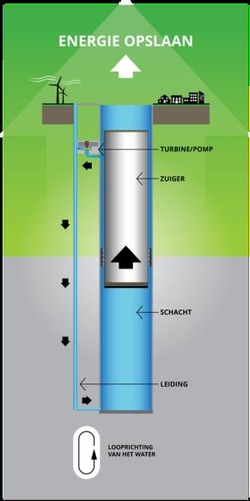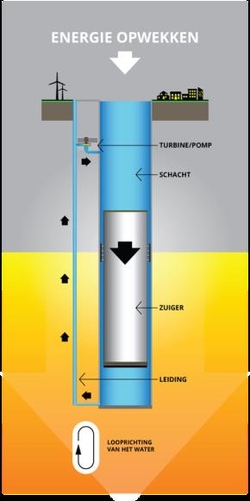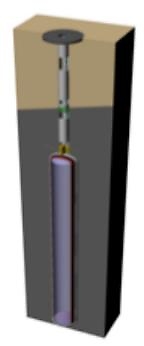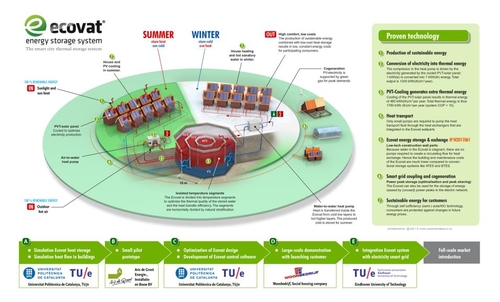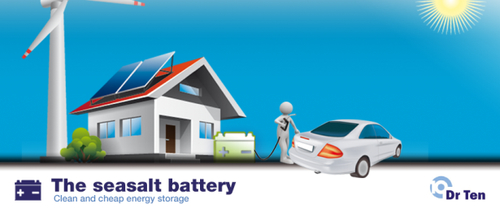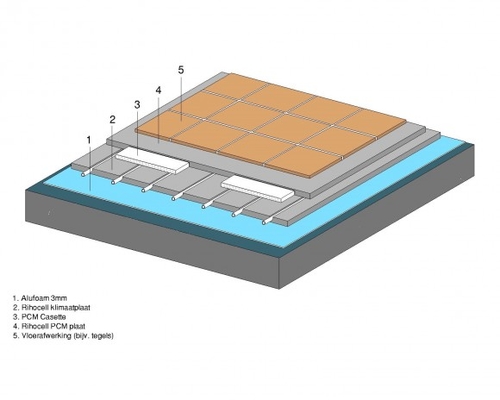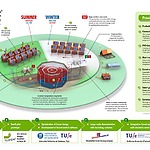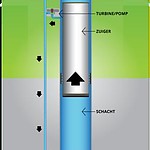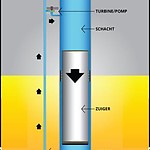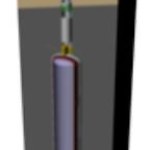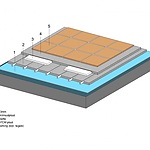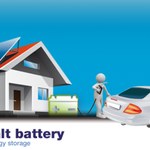Storing energy in the build environment
For centuries people use batteries to store energy and they become better, like the electric vehicle. But the potential of these batteries are very low. Many companies are designed new ways to store energy, the most potential ones will be discussed.
Water
Water has a very high potential and is one of the best mediums to store energy with. Now a days, when the wind turbines produce too much energy, the reservoir in Norway stop producing. When there is a lack, the reservoirs will start running again. With the potential of different water fall down, the generator starts spinning and produce in that way electricity. 99% pf the energy storage happens with water pump centrals. There are smart solutions, to “store” energy more local, it’s called “Gravity Power Module” designed by PWR technology. This company is specialized d in smart grid solutions and energy back-up systems for cases there is an lack of energy. When the energy grid is overloaded, the energy will drive a turbine, by doing this the piston will go up by the force of the water that is pump underneath it. When the energy is needed, the piston goes down and force the water to go up an through the turbine, which provide energy that is connected with the grid. Fig. 5 will show the process. The advantages of this product are the modularity, generating use of existing technology’s, its environmental friendly, flexible to place, eligibility, fast to construct and has low cost per megawatt. Next to this, It’s in different sizes avaible, it even can be placed in urban situations. Because it’s underground no visual pollution and a silent solution. The GPM has no emissions, the reaction time is very fast, within 20 sec. it can run full power (1-1600 MW)and hit has a very high efficient of 70-85% (up to 4 hours). The product is also durable with a lifecycle that could go up to 60 years.
Fig. 5: GPM Storing and producing energy
http://www.pwr.technology/smart-grid-energie-opslag.html
Pressed air
Compressed air could be very powerful, Parkid does research sins 2011 and developed the “Ucares” (Underground Compressed Air Renewable Energy Storage). Ucares can store sustainable produced energy. on/off shore wind turbines and solar panels, in the underground. The type of underground is unimportant, it has a minimum footprint ( min. ᴓ 2m )and a large capacity. The volume of the system is about 1000-10.000 m3 with a pressure between the 100-200 bar, this produce an energy capacity f 20-200MWh. The cost are depending but should be less than 50euro/MWh. The system supposed to be running in 2020, the first pilot is stared. Figure 6 gives an impression of how the system should look like.
Fig. 6: Ucares impression http://www.park-id.com/assets/ucares-esy-gen-09nov2013-1.0.pdf
Storing thermally in the build environment
There is a large amount of waste heat in the Netherlands, manly form conversion processes of fossil energy. In total, 15∙109m³ of natural gas is vanished into the atmosphere. This is equal to 528PJ, which almost 50% of the total heating question for the Netherlands. In total heating is 40% of the total energy use. Heat is an important ingredient for exergy, in summer there is more than enough and in winter a shortage. To cover that gap, heat need to be stored seasonal. This means, there are 2 design question; one for storing heat/cold in the environment and two to design a LowEx house to make advantage of the exergy potential. Different solutions in and around the house, for storing heat and cold are possible. A few promising and proved technologies will be explained. The use of installations like heat exchangers etc. will follow in the next chapter of this paper.
Underground
The earth is a stable factor and has a continuous temperature of 10-12 ᵒC at 10m deep. Each 100m deeper the temperature rises with 3 ᵒC. When the temperature reaches 80ᵒC (3km), it’s possible to produce energy with it. There are different options to make advantage of the underground.
horizontal ground heat exchanger: this are cables placed 1-2 meter in the underground. The dimensions of the exchanger are based on the local soil conditions. Though, it requires a large surface area.
Vertical ground heat exchanger, or “monobron”; these are piles, that go to deeper into the ground. Because, these product go deeply into the ground a proper soil analysis and experienced companies in this type of work is required. A common company in the Nederland’s is sixway, they place exchangers underneath the funding piles. Heat and cold could also be stored in an open source system. In this case water is pump in aquifers. But, for making advantage of the combining potentials of water and the underground, there are other more effective design.
http://www.iftechnology.nl/diensten
http://www.bodemenergienl.nl/Bodemenergie/Werkingsprincipe
http://www.klimaatconcept.nl/index.php/14-product-overzicht/75-warmtepomp-met-bodemwisselaar
http://www.sixways.nl/bodemwisselaars
Water
Worldwide there is a need for long time heat storage, Ecovat designed an innovative system for storing heat in the underground with water as a medium. They work together whit companies like KIC InnoEnergy, VITO EnergyVille, Saxion TU Eindhoven etc. The system is based on a container-in container principle, the system is modular and easy to construct. Through the different segments in the vessel, different temperatures can be stored from high (90ᵒC) to low (5ᵒC), to fulfill the question. The heat exchanging by integrated exchanger in the wall. The product has a high efficient with 90% over a half year and is 30% more efficient than mixed storage. The product should be adapted in a smart grid, as shown in fig. 9, where sustainable heat and cold is provided.
Fig. 9: Ecovat smart grid integrated system
http://www.ecovat.eu/over-ecovat/thermische-energieopslag/
http://www.energy-os.nl/oplossingen/pcm-(fase-overgangsmateriaal)/
http://www.joostdevree.nl/shtmls/pcm.shtml
http://www.autarkis.nl/nl/producten/wat-zijn-pcm's
Storing energy in houses
Salt
Dr. Ten is a Dutch company doing research in storing energy in a Sea salt battery, they have many partners like the TU Delft, University of Twente but also Ministry of Economic Affairs and smart city collective. The sea salt battery is a clean and consist out of cheap products like sea salt, carbon and water (fig. 7). The battery is able to fully discharge in contrast with usual battery’s. The battery has an power efficiently of 90%, it produce 30-40 Wh/kg and improving’s are still feasible. The battery could be charged over 7000 times, this never achieved before and each cycle cost about 1-2 cent/kWh. The salt battery is a natural, the most cleanest and cheapest battery on this moment and suitable for stationary storage of solar/wind energy, temporarily storing from the electricity grid and would be an outstanding charging station for electric vehicles. This product can help changing the shift to sustainable energy, electric cars and a strong, stable and smart grid with decentral energy storage and production. Also with the production, installation and management of the battery jobs are created. Al these positive points are rewarded with the Jan Terlouw innovation price of 2014.
fig. 7: Sea salt battery concept http://www.drten.nl/zeezout-batterij/
Storing thermally in houses
Water
On small scale, warm and cold water can be stored temporally in boiler, it should be used within a week, otherwise the efficiently becomes very low.
Phase Changing Materials
The technology where this process is based on exist over 4000y, for example thick floors and walls (mass) absorbed the heat of the sun, this comes free in winter so heating becomes almost superfluous. Though, no a day’s building massive walls and floors is to expansive. The PCM’s store and give heat/cold at the moment the temperature of the surrounding environment passes the activation value. In general there are 2 types, organic and an-organic, the an-organic have a higher thermal conductivity and capacity, but they are toxic, flammable and hard to keep in good condition through connections with water or air.
The process is based on temperature difference. When the environment is warmer, the PCM becomes solid. While doing so, the material store heat inside, and cools down the environment. When the environment is to cold, the solid PCM becomes liquid. In this process, heat is released, and will heat up the environment. These processes will continue until the ideal temperature of the surrounding is reached.
An only Dutch company that produce organic PCM’s is Energy outsourcing solutions, they work together with Boonstoppel and Global-E-Systems. Their product is 100% recycle, it have a power reduction of chillers and heat pumps with 50-80%,it reduce 45% of the gas consumption and 40% of the electricity consumption. Besides that, it have low operating coast and a pay-back period within 3 years. The product functions optimal while combining it with heat pumps, boilers, chillers, aquifers, and ground collectors. There are more producers and companies doing reseach in this topic, like OCG autarkis group and De orange Climate Group. PCM’s could be stored in large boilers, but could also be placed in the floor; as floor heating (23ᵒC) or wall heating (20ᵒC). The PCM’s can be processed into boilers, tubes and panels. The building climate would become more stable with less temperature different in summer, winter, day and night.
Fig. 10: Ceiling system of OCG Autarkis (Retrieved: nrp.nl)
